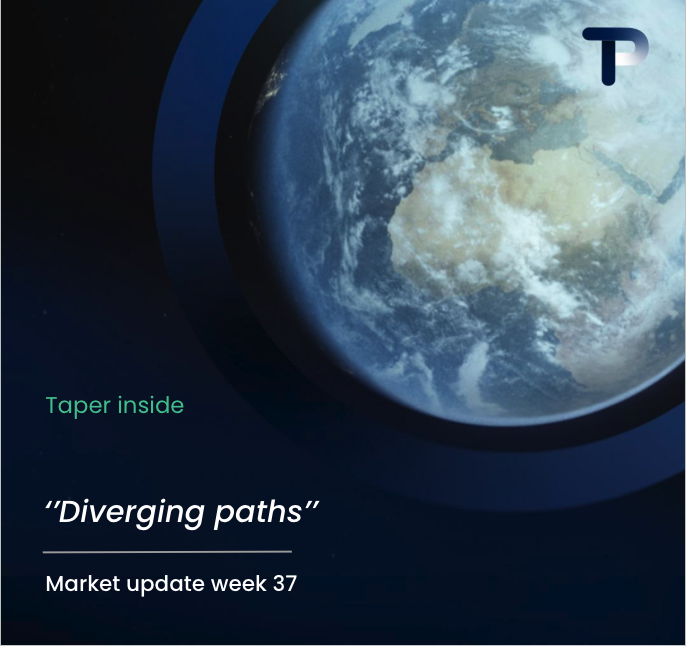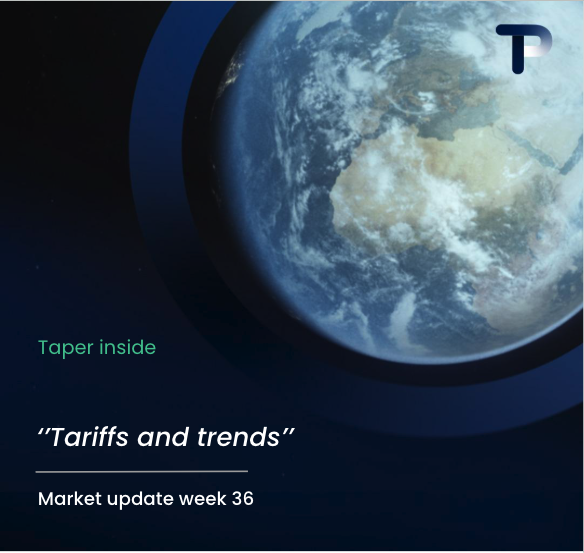For the dollar, last week’s jobs report was in focus. Despite a disappointing 143,000 new jobs added in January, other key figures were strong. The unemployment rate dropped from 4.1% to 4.0%, and average hourly earnings rose by 0.5% month-over-month, signaling a resilient labor market. This supports the Federal Reserve’s decision to keep interest rates unchanged and strengthens the case that rate cuts are unlikely this year, especially with potential new import tariffs on the horizon. However, markets seem to be paying little attention to these figures for now, given the political changes ahead. The dollar remained steady after the report’s release, but the data reinforce the image of a robust U.S. economy.

This week, the dollar’s upward momentum appeared to pause as traders adjusted their positions. However, looking at last year’s performance, it’s clear that the “Trump Trade” — betting on a stronger dollar — was the big winner, with the currency gaining approximately 4%.
In contrast, the Canadian dollar and Mexican peso emerged as major losers in response to the announced trade restrictions. Interestingly, the Chinese yuan actually strengthened, which seems counterintuitive. This suggests a potential opportunity for RMB weakness in the near future, similar to what we observed during the previous Trump administration. After all, a weaker yuan remains one of China’s most effective tools to support exports in any trade conflict with the United States.

This Sunday, Trump once again dominated the headlines by announcing universal tariffs on all steel and aluminum imports into the U.S. Additionally, during the interview, he hinted at introducing “reciprocal” levies on any country that imposes taxes on the U.S. He also emphasized his desire to keep the steel industry under American control, allowing only limited foreign investment.

The dollar strengthened again in response, while equity markets lost ground and risk sentiment deteriorated further in an already tense environment.
Meanwhile, the Trump administration is once again in focus, with rumors suggesting it will present a plan at the Munich Conference (Feb. 14–16) aimed at restoring peace in Ukraine—at least according to Trump. While this is not immediate macroeconomic news, we believe a resolution in the region could be positive for the euro. Additionally, the potential return of cheap Russian energy to the market could have significant economic implications. While certain climate-focused political groups in Europe may oppose this, it would likely be welcomed by industry.
The topic has already dominated news channels over the weekend, with reports suggesting that Trump is in contact with Putin and that Zelensky may have offered crucial raw materials in exchange for support. We are closely monitoring developments.
Europe
In Europe, the debate has once again turned to interest rates. How much further can the ECB cut them? After reducing the deposit rate to 2.75% on Jan. 30, the key question is: What comes next?
While the struggling European economy could benefit from additional support, the ECB must also avoid triggering inflationary pressures or overheating the market with excessive monetary easing. The central bank is ultimately seeking a “neutral” rate—one that neither restrains nor stimulates economic growth. Based on market surveys, we expect the ECB to implement a few more rate cuts in 2025, likely in the range of 2 to 3 reductions of 25 basis points each.

Interestingly, ECB Vice President Luis de Guindos made notable remarks, explicitly pointing to another key measure: the ECB Bank Lending Survey. He argued that bank lending conditions provide a more accurate gauge of market dynamics and the need for interest rate adjustments.
This reasoning is logical—after all, in a more restrictive monetary environment, lending activity tends to slow, while in looser conditions, liquidity flows abundantly. The state of loans granted by the banking sector offers a clear snapshot of these trends and serves as a valuable indicator for future policy decisions.

ECB President Christine Lagarde, on the other hand, mentioned a target range of 1.75%–2.50%, making it clear that the EU still has several interest rate decisions ahead.
EUR vs. USD
With the Federal Reserve appearing to pause interest rate moves for now, we are preparing for a scenario where interest rate levels between the U.S. and the EU continue to diverge. This is already reflected in the stronger dollar (driven by higher interest rate expectations) and the weaker euro (due to lower expectations).
Currently, U.S. interest rates remain in the 4.25%–4.50% range, while longer-term forecasts for the federal funds rate suggest a decline toward 3%. However, the Fed’s reluctance to cut rates—largely due to the strength of the U.S. economy—continues to keep both interest rates and the dollar elevated.
Given the current landscape, we see the dollar remaining expensive, with some market participants even considering a return to 1:1 parity against the euro. Factors contributing to this include weak EU economic performance, Trump’s proposed tariffs, and widening interest rate differentials.

We do see several scenarios that could reverse the current trend:
- A ceasefire in Ukraine (geopolitical)
- Increased government spending in Germany (economic)
- Stronger economic data from China (economic)
- U.S. recession (economic)
In the short term, our primary focus is on scenario (1)—a potential de-escalation in Ukraine—which could provide much-needed support for the euro.
For those interested, here is an insightful Bloomberg article:
This Week’s Outlook
This week is relatively light on the macroeconomic front. However, with the interest rate debate back in focus, upcoming speeches will be closely watched. On Tuesday, Fed member Hammack will speak, followed by Fed Chair Jerome Powell and member Bostic on Wednesday. Powell’s remarks, in particular, will be critical, as markets will carefully analyze his words for any signals on future policy.
Wednesday will also be the busiest day for U.S. economic data, with key releases including inflation figures and the federal budget statement. On Thursday, attention will shift to GDP growth data and the manufacturing sector.
We expect Powell to reinforce the narrative of a “strong economy”, which supports the Fed’s cautious stance on rate cuts. The persistence of inflation in recent months suggests that the Fed sees no urgency to ease policy, as higher interest rates remain an effective tool to curb inflationary pressures.


From Europe, the news flow is relatively limited this week. On Thursday, German inflation figures will be in focus, though no major surprises are expected. However, industrial production data could pose a risk, as a potential setback may be on the horizon.
On Friday, key releases include GDP growth, German wholesale prices, and EU employment data.
U.S. data to watch
Also on Friday, U.S. retail sales will be closely monitored, as a strong reading would reinforce the narrative of a resilient economy. Additionally, we’ll see a set of import/export price data, business inventories, and industrial production figures. Given the upcoming trade tariffs, we will be paying even closer attention to these indicators in the coming period.
With the EU’s GDP figures also set for release, we see the potential for a “near miss” or downside surprise, which could weigh on sentiment.
In short, there’s plenty happening this week! We’ll be keeping a close watch on developments, and if you have any questions, feel free to reach out.
Monday
- (No major events listed)
Tuesday
- UK: BRC Retail Monitor
- US: FED member Hammack speech
Wednesday
- US: Inflation Rate, CPI, Core Inflation
- US: FED Chair Jerome Powell speech
- US: Monthly Budget Statement, FED member Bostic speech
Thursday
- US: GDP Growth, Trade Balance, Manufacturing Sector Development
- US: PPI (Producer Price Inflation)
- Germany: Inflation Rate
- EU: Industrial Production
Friday
- Germany: Wholesale Prices
- EU: GDP Growth, Employment Data
- US: Retail Sales, Industrial Production, Import/Export Prices, Business Inventories



